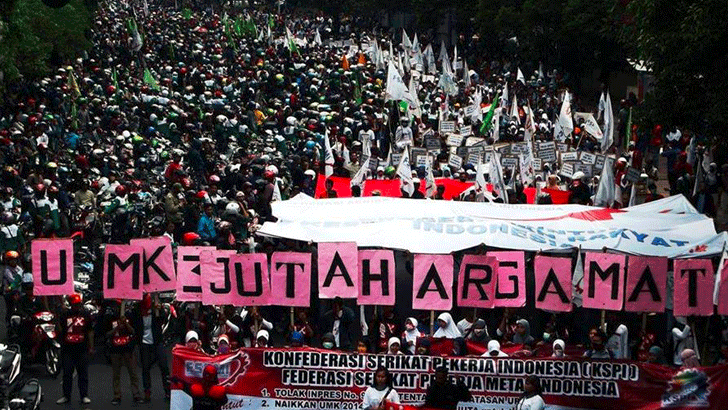Indonesia’s labour movement stirs

Widespread strikes and worker protests took place in many Indonesian town and cities on 31 October and 1 November. On the first day of the strike, the Indonesian police stated that they had noted actions in 50 towns and cities in 15 provinces.
The protesters had three main demands: a 50 percent increase in the minimum wage, an end to all illegal labour hire (“outsourcing”) and a social insurance scheme for all Indonesians.
The actions were organised by a coalition called the Labour Movement National Consolidation (KNGB), formed three weeks before the strike. The KNGB comprised the Confederation of Indonesian Trade Unions (KSPI), the Workers Joint Secretariat (Sekber Buruh), National Trade Union Confederation (KSN) and several other union federations and regional alliances. The KSPI includes the Metalworkers Trade Unions Federation (FSPMI), which has been at the heart of many major actions over the last three years.
A national strike with similar demands was held in October 2012 organised by the Indonesian Workers Assembly (MPBI), which comprised the KSPI, KSN, Confederation of the All Indonesian Workers Union and the Confederation of Prosperity Labour Unions. Wage increases of 40 percent and more were won as a result of that strike, although many employers are still resisting paying up.
It appears that KNGB was formed in response to a breakdown in the unity of the MPBI. While only two of the big confederations from 2012 are in KNGB, the new alliance includes the openly left wing Workers Joint Secretariat. Although the Workers Joint Secretariat can mobilise only small forces, its involvement is a major advance in ending separate mobilisations. The KNGB also involved many local alliances of enterprise level unions, which may have involved members of all the MPBI unions.
It is difficult to assess how many workers took part – probably several hundred thousand. Activists report that in the industrial belts around Jakarta, production was stopped in about 40 percent of factories, despite the abstention of two large confederations.
There was also systematic harassment, especially in the factory belt areas, by groups of uniformed gangs, mostly belonging to the Pemuda Pancasila (PP). This group was formed during the Suharto dictatorship as a weapon of the state. The PP and other groups mobilised to prevent workers leaving factory compounds or factory neighbourhoods to join mobilisations.
In some cases there were physical attacks, resulting in workers being hospitalised with stab wounds and slashes. Later, there were clashes between organised workers and the PP and other similar groups. Police were often present but usually did nothing to stop the PP, although some gang members were arrested.
In other areas such as in Sumatra and Sulawesi, the police attacked protesters and detained some for several hours. On the factory island of Batam, off Singapore, it is reported that the factory belt areas were brought to a total halt.
Recovering from dictatorship
Militant trade unions first arose in the 1920s in Indonesia and were engaged in many important campaigns over the next four decades, including winning nationalisation of all former colonial companies in the 1950s, the repudiation of foreign debt in 1957 and the appointment of worker representatives on the board of management of many state-owned companies in the 1960s. After General Suharto took power in 1965, unions disappeared for several years.
Between the early 1970s and 1998, there was only one union – tightly controlled by the dictatorship and used as a weapon to control workers. During these 33 years, new generations of workers entered into a workforce in which trade unionism had almost disappeared. Since the end of the dictatorship in 1998, and especially since 2000, independent trade unionism has slowly re-emerged.
Key in developing a militant wing have been sections of the FSPMI, a union with a large, well-organised membership based in manufacturing and assembly plants, including the automotive sectors.
Consciousness in these very new unions, at all levels of leadership and among the factory base, is very uneven. There is constant struggle and argument over the best tactics and levels of militancy required. There is not yet a developed practice of strikes (stopping production), most worker protest mobilisations taking place outside shift hours.
The 40 percent participation in stopping production in the factory areas was a significant advance on this front. A crucial technique to achieve this turnout is “sweeping”. Workers from one factory gather outside of factories still operating and call on the workers to join them. They chant and bang on the factory gates.
The practice developed during 2011 and 2012, when workers from one factory would mobilise to show support for workers on strike or involved in conflicts with management at other factories. This inter-factory solidarity over the last few years has fostered an atmosphere that has made “sweeping” feasible.
There has also been an active “ekopol” education campaign, originally hosted by the FSPMI, which has brought progressive labour movement ideology into the factory belts around Jakarta and in other provinces. Although the FSPMI has recently ended these courses for being too left wing, other unions have started to host them.
The timing of the strikes was linked to the wage-fixing process. The minimum wage is fixed annually by municipal and district governments on the advice of a tripartite wage council.
The governor of Jakarta, Joko Widodo, incurred workers’ wrath when he confirmed that the Jakarta minimum wage would be raised only 10 percent. The unions have assessed that the cost of living is such that a 50 percent increase is needed to achieve a decent standard of living. Most surveys show that the workers’ real purchasing power has decreased drastically over the last decade. Other local governments have yet to announce their decisions.
While the media and the new middle class and its twitterdom have generally been hostile to the strike, a positive sign has been the many campus student actions in solidarity with the workers. Human rights NGOS and similar groups have also expressed solidarity.